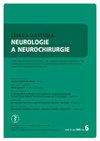药物诱导睡眠内镜在气道正压滴定中的作用-初步结果
IF 0.4
4区 医学
Q4 NEUROSCIENCES
引用次数: 0
摘要
目的:本研究的目的是监测药物性睡眠内镜下气道正压(PAP)对特定梗阻部位的影响,以评估在何种压力下梗阻消失/恶化,并阐明PAP不耐受的可能原因。材料与方法:在2018年6月至2020年12月期间,对20例既往未接受治疗的阻塞性睡眠呼吸暂停患者在药物诱导睡眠内镜下行PAP检查。在检查过程中,确定上呼吸道梗阻部位,评估PAP通气过程中不同的压力设置如何反映上呼吸道的行为,以及其扩张或塌陷导致其梗阻。监测开始于6 hPa的压力,在6 - 18 hPa的范围内逐步增加2 hPa的压力。每次压力施加至少20秒。采用基于Kezirian的VOTE分类对结果进行评价,并相互比较。结果:PAP在软腭区前后梗阻时效果最佳,平均开口压力为11.2 hPa。对于外侧口咽阻塞,平均开口压力为12 hPa。20例患者中有8例PAP无效,6例因软腭同心性或外侧梗阻,2例因会厌塌陷。在会厌塌陷时,PAP通气不能使气道放松,因为随着PAP压力的增加,会厌在咽后壁的阻塞和吸力加剧。结论:PAP上呼吸道药物诱导睡眠内镜检查是一种简单易行的检查方法,可减少PAP不耐受(如会厌塌陷),从而优化治疗。我们假设压力装置的患者更好的依从性,谁是指这种治疗。Redakční rada potvrzuje, že rukopis práce splnil ICMJE kritacriia pro publiclikace zasílané do biomedicínských asopisje。编辑委员会宣布该稿件符合ICMJE对生物医学论文的“统一要求”。m . Masarova1 2 j . Seko1 m .解放军šek1, 2 m . Formanek1 2 o . Jor3诉Novak4, p . Kominek1, 2, p .那里šek1, 2 1 Klinika otorinolaryngologie一chirurgie hlavy krku LF OU FN斯特拉瓦2 Katedra kraniofacialnich一带一路ů,如果你,斯特拉瓦3 Klinika anesteziologie, resuscitace一intenzivni mediciny FN斯特拉瓦4椎体pro poruchy spanku bděni - spankova实验室里ř,奇怪ě雷尼·dětske neurologie,本文章由计算机程序翻译,如有差异,请以英文原文为准。
The role of drug-induced sleep endoscopy for positive airway pressure titration – initial results
Aim: The aim of the work was to monitor the eff ect of positive airway pressure (PAP) on the particular sites of obstruction during the drug-induced sleep endoscopy to evaluate at which pressure the obstruction disappears/worsens and to clarify possible reasons for PAP intolerance. Materials and Methods: In the period from 6/2018 to 12/2020, a PAP test was performed during the drug-induced sleep endoscopy in 20 patients with obstructive sleep apnea without previous therapy. During the examination, sites of obstruction in the upper respiratory tract were identifi ed. It was evaluated how the diff erent pressure set during PAP ventilation refl ects on the behaviour of the upper respiratory tract, and on its expansion or collapse leading to its obstruction. Monitoring was started at a pressure of 6 hPa, and gradually the pressure was increased stepwise by 2 hPa in the range from 6 to 18 hPa. Each pressure was applied for a minimum of 20 s. The fi ndings were evaluated using the VOTE classifi cation according to Kezirian and compared with each other. Results: The best eff ect of PAP was observed in the case of anteroposterior obstruction in the soft palate area, where the average opening pressure was 11.2 hPa. For laterolateral oropharyngeal obstruction, the average opening pressure was 12 hPa. PAP had no eff ect in 8/20 patients, 6 times due to concentric or laterolateral obstruction of the soft palate, and twice due to the collapse of the epiglottis. In the collapsing epiglottis, PAP ventilation does not relax the airways, because with increasing PAP pressure, the obstruction and suction of the epiglottis on the posterior wall of the pharynx worsens. Conclusion: Drug-induced sleep endoscopy of the upper airways with PAP is a simple and easy-to-perform examination which can reduce PAP intolerance (e.g., in the event of an epiglottis collapse) and thus optimize the treatment. We assume better compliance of the pressure device in patients who are indicated for this treatment. Redakční rada potvrzuje, že rukopis práce splnil ICMJE kritéria pro publikace zasílané do biomedicínských časopisů. The Editorial Board declares that the manuscript met the ICMJE “uniform requirements” for biomedical papers. M. Masárová1,2, J. Seko1, M. Plášek1,2, M. Formánek1,2, O. Jor3, V. Novák4, P. Komínek1,2, P. Matoušek1,2 1 Klinika otorinolaryngologie a chirurgie hlavy a krku LF OU a FN Ostrava 2 Katedra kraniofaciálních oborů, LF OU, Ostrava 3 Klinika anesteziologie, resuscitace a intenzivní medicíny FN Ostrava 4 Centrum pro poruchy spánku a bdění – spánková laboratoř, Oddělení dětské neurologie,
求助全文
通过发布文献求助,成功后即可免费获取论文全文。
去求助
来源期刊
CiteScore
0.70
自引率
60.00%
发文量
37
审稿时长
4-8 weeks
期刊介绍:
The Czech and Slovak Neurology and Neurosurgery is the official journal of five Czech and Slovak expert societies: the Czech Neurological Society, Slovak Neurological Society, Czech Neurosurgical Society, Slovak Neurosurgical Society and the Czech Society of Paediatric Neurology.
The journal is intended for all physicians interested in neuroscience, practical or theoretical.
The journal publishes original practice-based as well as basic research-focused neurological and neurosurgical papers, brief communications and case studies, all vigorously peer-reviewed, as well as review papers, commentaries, diagnostic and treatment standards and various thematic series (minimonographs with a knowledge test, statistical or web insights).

 求助内容:
求助内容: 应助结果提醒方式:
应助结果提醒方式:


